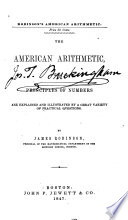 | Daniel Adams - Arithmetic - 1840 - 278 pages
...third, and so on, with a common difference of 3 cents ; what was the cost of the last yard ? Hence, when the first term, the common difference, and the number of terms, are given, to find the last term, — Multiply the number of terms, less 1, by the common difference, and add... | |
 | William Ruger - Arithmetic - 1841 - 268 pages
...series. What are numbers called when they decrease by a continual subtraction t A. A descending series. When the first term, the common difference, and the number of terms are given, how do you find the last term 1 A. By multiplying the number of terms, less one, by the common difference,... | |
 | Charles Haynes Haswell - Engineering - 1844 - 298 pages
...term, the t, -int. term, the Number of terms, the COMMON DIFFERENCE, and the SUM of all the terms. When the First Term, the Common Difference, and the Number of Terms are gieen, to find the Last Term. RULE. — Multiply the number of terms less one, by the common difference,... | |
 | James Bates Thomson - Algebra - 1846 - 276 pages
...z=a±(n — l)d. in which a, n and d are given. QUEST. — How is the sum of all the terms found 1 When the first term, the common difference, and the number of terms are given, how is the last term found ? Transposing (n — l)d, 2. The first term, a=z±(n—l')d, z, w and d... | |
 | James Robinson (of Boston.) - 1847 - 304 pages
...and that the last term, 19, is 8 times the common difference greater than the first term ; therefore, when the first term, the common difference, and the number of terms, are given to find the last term, we have the following rule. RULE. Multiply the common difference by the number... | |
 | Charles Haynes Haswell - Engineering - 1851 - 346 pages
...term, the Last term, the Number of terms, the Co MM: OS DIFFERENCE, and. the SUM of all the terms. When the First Term, the Common Difference, and the Number of Terms are given, to find the Last Term. RULE. — Multiply the number of terms less one, by the common difference, and... | |
 | Charles Haynes Haswell - Engineering - 1853 - 318 pages
...First term, the Last term, the Number oi terms, the COMMON DIFFERENCE, and the SUM of all the terms. When the First- Term, the Common Difference, and the Number of Terms are given, to find the Last Term. RULE. — Multiply the number of terms less one, by the common difference, and... | |
 | Thomas H. Palmer - Arithmetic - 1854 - 356 pages
...3. The common difference, d. 4. The number of terms, n. 5. The sum of the series, s. CASE I. Where the first term^ the common difference, and the number of terms, are given, to find the last, or any intermediate term (a, dt nt to find z). Exemplification for the Slack-board.... | |
 | Thomas H. Palmer - Arithmetic - 1854 - 368 pages
...3. The common difference, d. 4. The number of terms, n. 5. The sum of the series, t. CASE I. Where the first term, the common difference, and the number of terms, are given, to find the last, or any intermediate term (a, d, n, to find z). • Exemplification for the Slack-board.... | |
 | Robert Potts - 1863 - 482 pages
..._=_.(._.? yzbczxcaxyab 8. Find the expression for the sum of an- arithmetical progression of which the first term, the common difference, and the number of terms, are given. If the common difference is equal to twice the first term, prove that the quotient of the sum divided... | |
| |